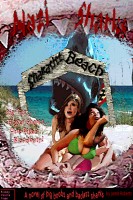Guy Maddin was apparently immersed in French decadent writers during the preparation for Twilight of the Ice Nymphs, and writer George Toles was immersed in austere Nordic literature, Knut Hamsun in particular. Ice Nymphs, as such, is a clash of two radically opposed attitudes toward art and existence. Visually, it is morbidly indulgent in the cheerful artifice of decadence, whereas the characters and their impressionistic dialogue reveal the inhabitants of the pleasant world to be remarkably displeased, dreary, in agony. Such a gorgeous world and not a soul to enjoy it.
That is the real tragedy of Ice Nymphs and its major theme: imprisonment. These are self-involved, unfulfilled people in a world that promises boundless fulfillment. Mandragora is a mid-summer night's paradise, but hell is other people. I'm reminded of Alain de Botton's thoughts on travel. He argues that while people travel far from their familiar land in the hope for release and renewal, as if it was their location that prevented them from relaxing and freeing themselves, they can never travel away from themselves. Maddin and Toles' characters are imprisoned within themselves. The motif of imprisonment is repeated often, but it is no external prison that holds these characters: they are free in the lush land of Mandragora, but trapped within themselves.
Ice Nymphs is about a man, Peter, returning to the underground island of Mandragora, where the sun never sets, after a long stay in prison that left scars on his wrists. While on ship he meets a beautiful girl. She disappears, but he can't get her out of his mind. Arriving on Mandragora, he finds his spinster sister Amelia in a bitter conflict with her old servant. He wants to buy her ostrich farm and his patience is wearing thin. Amelia wants to get married first and has her eye set on a Dr. Solti, who is more a magician in the spirit of The Tempest's Prospero than a mad scientist, though there's more than a hint of Bride of Frankenstein's Dr. Pretorius in him. Solti, however, has fallen for the beautiful assistant who nursed him after his statue crushed his leg. And wouldn't you know it, the assistant is the girl from the boat. Complicating the matter is the fisherman's wife Zephyr, with whom Peter has already struck up a sexual relationship. Thus is the complicated love pentangle.
I suppose it was a brave decision for Maddin to leave Toles' very stylized dialogue as it was written. Not only that, but for a Maddin picture, Ice Nymphs is dialogue heavy indeed. Sounding not unlike the elementary English of a children's program with a broader vocabulary (including 'fuck'), it can be distracting, even if the artificiality is right at home with Maddin's decadence. Along with the purple colours, boats, and the style of dialogue, I was reminded immediately of Fassbinder's Querelle, though Maddin claims not to have seen a single Fassbinder picture at that point. Like Querelle, an effort on the part of the audience is required to get into the world at hand and even then the conceptual rather than real emotional lives of these characters tends to be rather boring.
As far as being a work of decadence goes, I think Maddin may have missed his mark. Ice Nymphs looks and feels much more symbolist than decadent. The movements were very closely linked, but not the same. Maddin claims his visual guide was Gustav Moreau (a symbolist) and that the bright colours are a result of printer brightening. While I'm sure Maddin wouldn't lie, the surface articulation that is such a prominent feature in Moreau is mostly lacking in Ice Nymphs, with the exception of Solti's lab, and that can't be explained by printer errors. I was reminded much more of Odilon Redon's late colour pastels. Maddin had just done a short two years prior to Ice Nymphs in the visual style of Redon's early black and white works; Ice Nymphs feels like a visual sequel, as it were.
Maddin said in an interview or commentary somewhere--I forget where--that nothing worked in Ice Nymphs. I think he's being too harsh on himself. It's as visually beautiful a fantasy as one could ask for, due to the aesthetic, yes, but also to the lovely women, Pascale Bussieres, Alice Krige, and Shelley Duvall. Toles, moreover, comes up with some wonderful speeches for his characters, with Solti and Amelia getting the best of them. Nevertheless, Twilight of the Ice Nymphs, while certainly worth watching and even worthy of its comparison to what I believe to be the superior Querelle, is far from a complete success. A lesser Guy Maddin picture is like a lesser Rembrandt painting: far better than these eyes deserve. I'm grateful Maddin made Ice Nymphs and you should be, too.
Help make this site more interesting through discussion:
Twilight of the Ice Nymphs (1997)
Author: Jared Roberts
Subscribe to:
Post Comments (Atom)

2 comments:
I've not seen a single film from this director but every time I read a review it piques my interest. When I get around to it I'll try to find copies of The Dead Father and Tales from the Gimli Hospital and then work my way up from there.
Maddin is one of Canada's national treasures. But to be honest, I sometimes wonder how much substance is under his style. I started with The Saddest Music in the World, which was made when he started to get some real budgets and clout. I daresay Saddest Music and Ice Nymphs are the only features of his I have seen. I've mostly seen his shorts. Many of these are on youtube, including his latest existential epic Spanky: To the Pier and Back. Definitely worth taking four minutes out of your life to see Spanky: To the Pier and Back, which is about Spanky walking to the pier and back.
Post a Comment